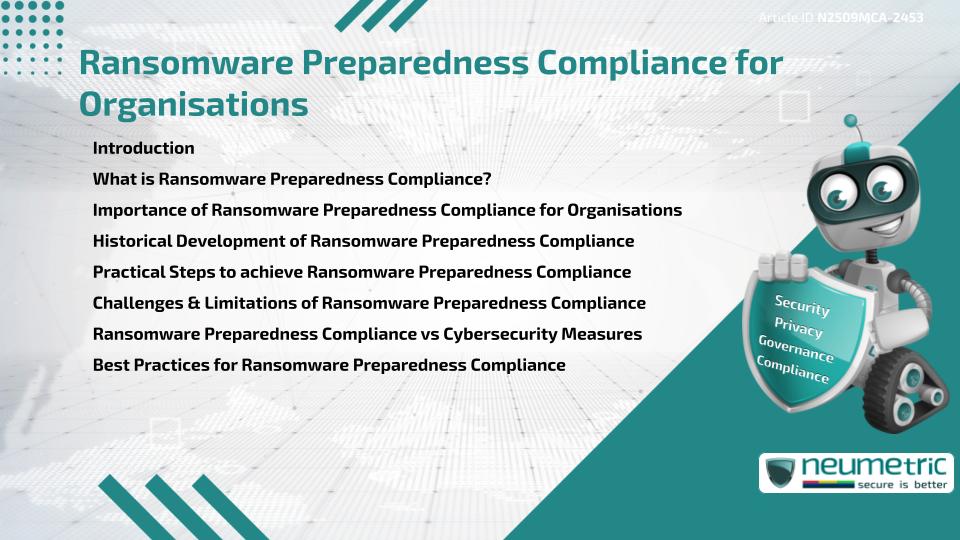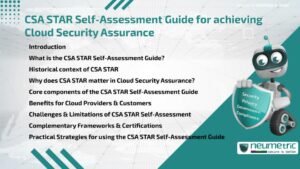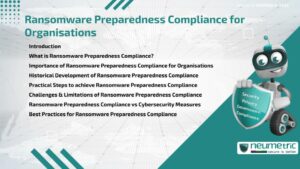Table of Contents
ToggleIntroduction
Ransomware Preparedness Compliance refers to the structured approach organisations take to protect against Ransomware Threats while ensuring adherence to Regulatory & Policy requirements. This form of Compliance focuses on prevention, detection, response & recovery strategies that align with Industry Standards & laws. For organisations, Ransomware Preparedness Compliance strengthens Cybersecurity resilience, limits Financial damage & reinforces Stakeholder confidence. This article examines its meaning, importance, history, practical steps, challenges, comparisons & Best Practices.
What is Ransomware Preparedness Compliance?
Ransomware Preparedness Compliance is the integration of Ransomware-specific protection & recovery measures into an organisation’s Compliance Framework. It ensures that Security Controls, such as Data Backup, Access Control & Incident Response, meet both Regulatory Standards & internal Policies. Like preparing for fire safety inspections, Ransomware Preparedness Compliance requires organisations to maintain preventive measures & demonstrate proof of readiness.
Importance of Ransomware Preparedness Compliance for Organisations
The rise in Ransomware attacks makes Ransomware Preparedness Compliance vital:
- Financial Security: Prevents or reduces costly ransom payments & downtime.
- Regulatory Alignment: Meets legal obligations under frameworks like GDPR & HIPAA.
- Reputation Management: Demonstrates responsibility to Clients, Regulators & Investors.
- Operational Continuity: Ensures businesses can recover quickly after an attack.
Without Ransomware Preparedness Compliance, organisations Risk severe Financial penalties, Loss of data & Reputational harm.
Historical Development of Ransomware Preparedness Compliance
Ransomware first appeared in the late 1980s, but the Threat became widespread in the early 2000s with more advanced variants. Initially, organisations treated Ransomware as a general Cybersecurity issue. However, the growing frequency & severity of attacks, combined with regulations around Data Protection, led to the evolution of Ransomware Preparedness Compliance. Authorities & Cybersecurity agencies, such as NIST, began issuing frameworks & guidelines, embedding Ransomware protection into Compliance programs.
Practical Steps to achieve Ransomware Preparedness Compliance
Organisations can take several steps to strengthen Ransomware Preparedness Compliance:
- Risk Assessments: Identify Vulnerabilities across systems & processes.
- Access Controls: Enforce Multifactor Authentication & Least Privilege Policies.
- Data Backups: Maintain secure, encrypted & regularly tested backups.
- Incident Response Plans: Develop & rehearse Procedures for Ransomware attacks.
- Continuous Monitoring: Detect anomalies with real-time Security tools.
Challenges & Limitations of Ransomware Preparedness Compliance
Despite its benefits, Ransomware Preparedness Compliance faces challenges:
- Evolving Threats: Attackers constantly change tactics, making Compliance a moving target.
- Resource Constraints: Smaller organisations may lack the budget for advanced tools.
- Human Error: Employees can unintentionally expose systems through phishing or weak passwords.
- Regulatory Overlap: Aligning Ransomware measures with multiple standards can create confusion.
These limitations underscore the need for adaptable strategies & regular reviews.
Ransomware Preparedness Compliance vs Cybersecurity Measures
General Cybersecurity measures cover a broad spectrum of Threats such as Phishing, Malware & Denial-of-Service attacks. Ransomware Preparedness Compliance narrows the focus specifically to Ransomware, requiring stricter Backup Protocols, faster Recovery Plans & stronger Incident Reporting. It can be compared to specialised fire drills: while general safety drills prepare for all emergencies, Ransomware-specific drills prepare for one of the most disruptive types of attacks.
Best Practices for Ransomware Preparedness Compliance
To maintain Ransomware Preparedness Compliance, organisations should:
- Train Employees regularly on Phishing Awareness & Ransomware Risks.
- Use automated Patch Management systems to reduce Vulnerabilities.
- Segment networks to prevent Ransomware spread.
- Align Compliance programs with international standards like ISO 27001.
- Test recovery procedures through simulated Ransomware attacks.
Best Practices transform Compliance from a box-ticking exercise into a culture of resilience.
Conclusion
Ransomware Preparedness Compliance is critical for organisations aiming to reduce Risks & strengthen Security against one of the most damaging Cyber Threats. By understanding its history, applying practical steps, addressing challenges & embedding Best Practices, organisations can achieve Compliance while building a resilient defense.
Takeaways
- Ransomware Preparedness Compliance protects organisations from Financial, Regulatory & Reputational damage.
- Its development reflects the growing severity of Ransomware attacks.
- Practical steps include Risk Assessments, backups & Incident Response planning.
- Challenges involve evolving Threats, human error & resource limitations.
- Best Practices foster a culture of preparedness & resilience.
FAQ
What is Ransomware Preparedness Compliance?
It is the integration of Ransomware protection measures into Compliance frameworks to meet Legal & Security standards.
Why is Ransomware Preparedness Compliance important?
It reduces Financial loss, ensures Regulatory alignment & maintains Business Continuity.
What are the key steps in Ransomware Preparedness Compliance?
Key steps include Risk Assessments, backups, Access Control & Incident Response planning.
How does Ransomware Preparedness Compliance differ from general Cybersecurity?
It focuses specifically on Ransomware Threats, requiring tailored recovery & reporting measures.
What challenges do organisations face in Ransomware Preparedness Compliance?
Challenges include evolving Threats, resource shortages & Employee errors.
Can small organisations implement Ransomware Preparedness Compliance?
Yes, by focusing on affordable measures such as staff training & secure data backups.
How often should Ransomware Preparedness Compliance be reviewed?
It should be reviewed at least annually or after major system or regulatory changes.
What role does Employee Training play in Ransomware Preparedness Compliance?
Training helps staff recognise & avoid Ransomware Threats, reducing Risks of attack.
Need help for Security, Privacy, Governance & VAPT?
Neumetric provides organisations the necessary help to achieve their Cybersecurity, Compliance, Governance, Privacy, Certifications & Pentesting needs.
Organisations & Businesses, specifically those which provide SaaS & AI Solutions in the Fintech, BFSI & other regulated sectors, usually need a Cybersecurity Partner for meeting & maintaining the ongoing Security & Privacy needs & requirements of their Enterprise Clients & Privacy conscious Customers.
SOC 2, ISO 27001, ISO 42001, NIST, HIPAA, HECVAT, EU GDPR are some of the Frameworks that are served by Fusion – a SaaS, multimodular, multitenant, centralised, automated, Cybersecurity & Compliance Management system.
Neumetric also provides Expert Services for technical security which covers VAPT for Web Applications, APIs, iOS & Android Mobile Apps, Security Testing for AWS & other Cloud Environments & Cloud Infrastructure & other similar scopes.
Reach out to us by Email or filling out the Contact Form…





